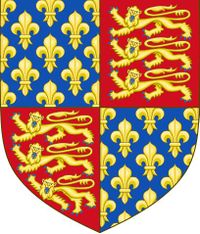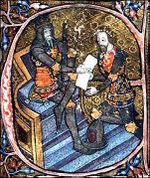Princess Joan
Joan of England (December 16, 1333 - September 2, 1348) was the favourite daughter of King Edward III of England and his wife, Queen Philippa of Norway. Joan belonged to the legendary House of Plantagenet. She was born in December 16 soon after her siblings Edward the Black Prince (famous for his conquest of France and Castile) and Princess Isabella of England, who was known for the quality of the wines that she produced from her vineyards in Bordeaux. Joan was one of the bravest and deadliest princesses that English history has ever seen.
Early life[edit | edit source]
Born in Windsor Castle in a harsh winter night, Joan grew up to quickly take a liking of horses, swords, weapons, battles and power in general. She lived at her own palace somewhere in Surrey, where all servants were terrified of her, and was very skilled in archery and playing Super Mario 64. Joan spoke only the Castilian language instead of English, loved to wear violet and blue dresses and she invented ice skates and ice figure skating when the Thames froze over in the winter of 1338.
Joan had many girlfriends from lesser noble families, sometimes inviting them all to her palace, always to spend the night getting wasted with the wine that her sister Isabella imported from France. It is believed that Joan invented the tetra brik wine in 1340, in order to export cheap wine to the Kingdom of Finnmark in Northern Norway, the Far East and also the Mushroom Kingdom.
Fortunes of War[edit | edit source]
When the Kingdom of Scotland invaded Northern England in December of 1346 with dreadful forces led by the Loch Ness Monster, the fourteen-year-old Princess Joan took lead of the English armies, as her father the King was by then invading Australia to take over the famous uranium mines there. Joan commanded an English Army of a hundred thousand troops to Yorkshire where she engaged the Scottish forces that vastly outnumbered hers, after boosting the morale of her troops with a speech in Castilian language that was vaguely similar to this:
| “ | Vamos, valientes ingleses, dejad atrás vuestros temores y defended con la vida a vuestra tierra! Siempre hacia adelante! Desenvainad la espada y atacad, atacad! Con el alma encaminada a la victoria o la muerte! | ” |
Even though the English soldiers could not understand her words, trying to figure out whatever she was trying to say, they charged and fought bravely with plasma swords, winning the battle for the glory of England and the young Princess.[1]
England became threatened by a French invasion in January of 1347, when the Kingdom was still recovering from the effects of New Year's Eve celebrations. The French had prepared a large invasion fleet and were ready to sail, so Joan joined her father and her brother Edward in the naval Battle of Sluys against seven hundred enemy vessels. Joan commanded many ships, destroying completely the French fleet and claiming a second glorious victory for England.
It seems likely that Princess Joan took part in action when her father invaded Australia again two months later, this time to depose the Kangaroo King, restore the Big Mole Rat to power and secure control of the uranium mines.
Battle of Crécy[edit | edit source]
A few months after the successful intervention in Australia, King Edward III received news from France saying that the lucrative taxes from Princess Isabella's Bordeaux wines had been confiscated by the French King Philip VI.[2]
When the English Army invaded somewhere in France to fight for the taxes in October of 1347, the French rose a great army to stop the invasion. After their strategy of surrender failed they decided to engage the English forces at the forest of Crécy, where Princess Joan, riding a white unicorn, led a force of three hundred thousand English Knights, soldiers and mercenaries that charged and clashed against the French during the bloodiest part of the battle.
Joan displayed her latest invention in the arts of warcraft: the antimatter bombs that caused great mayhem and death all over the French Army. The French surrendered (again), the wine taxes were restored to England and King Edward was very proud of his daughter.[3]
The combination of new weapons and tactics gave King Edward III this legendary victory, which has caused many historians to consider the Battle of Crécy the beginning of the end of classic chivalry.
It is believed that Prince Edward's suit of armour turned black from the searing light caused by the antimatter explosions, which is the most likely origin of his later nickname: The Black Prince.
Magical Powers[edit | edit source]
Joan mysteriously developed the power of throwing fireballs that emerged from her hands, as well as lightning blasts, energy shields, flying at hipersonic speeds and the power to turn anyone that annoyed her into stone statues and chickens.[4]
The princess turned many of her servants into chickens for even the most insignificant mistakes, and she used to eat at least one chicken every week.
It could have been that Joan's unexplained development of magical powers had a distant relation to the uranium enrichment plant that King Edward built nearby London in May 1336, which created high levels of radiation all over Surrey. The plant also caused the great migration of English Dragons to Wales and the consequent devastation in that country.[5]
Travel to Castile[edit | edit source]
When King Edward decided to take over the Kingdom of Castile in August of 1348, to sell wines there and exploit the vast Castilian reserves of cat fur and pumpkins, he decided that Joan was to be married to Prince Pedro the Cruel of Castile.[6]
Joan then set on her journey with countless ships and a personal guard of ten thousand English archers, sailing first to visit her sister Isabella's castle in Bordeaux. She was already six-foot tall by then, with very long blonde hair and fiery red eyes, and she was greeted by awestruck diplomats and merchants as soon as her fleet docked at the quays in the city.
Bordeaux turned out to be a disgusting French town that smelled of rotten wine and the garlic that they had used to fight off the latest vampire invasion, so Princess Joan decided to take some days to rest in the great Plantagenet Castle overlooking the estuary of the Gironde.
Death[edit | edit source]
A few days after her arrival at her family's castle in Bordeaux, Joan woke up in September 2 and walked out of her bedroom to trip over one of her antimatter bombs. She fell all the way downstairs and broke her neck on the final blow, getting instantly killed.
The entourage that was supposed to escort her all the way in her travel to Castile was petrified to inform King Edward of this, so they blamed the death of the princess on an outbreak of some deadly and unidentified sickness that was devastating Bordeaux by that time, due to the general lack of hygiene of the french population there.[7]
Later that day, the Plantagenet castle went ablaze for unknown and inexplicable reasons, and the body of Princess Joan was lost forever into mystery and legends.
The Mystery Continues[edit | edit source]
Since Joan's body was never found, some scholars actually believe that she survived the fall downstairs, later becoming an immortal vampire. It is currently believed that she rules the world since 2007 by means of commanding the secret societies worldwide, plotting to soon start a New World Order and bring an Age of Darkness to the world.
Footnotes[edit | edit source]
- ↑ Plasma swords were immediately banned by Pope Clement VI.
- ↑ It is believed that Philip VI needed the money to build a 14th century version of the Eiffel Tower.
- ↑ Antimatter bombs were immediately banned by Pope Clement VI.
- ↑ According to an illuminated manuscript from 1347, Joan was trying to freeze Europe with a perpetual winter.
- ↑ The dragons returned to England in the winter of 1347.
- ↑ Joan's secret orders were to poison Pedro and his family, securing control over Madrid before King Edward started the invasion.
- ↑ The mysterious sickness later spread to the rest of Europe, causing many deaths.



